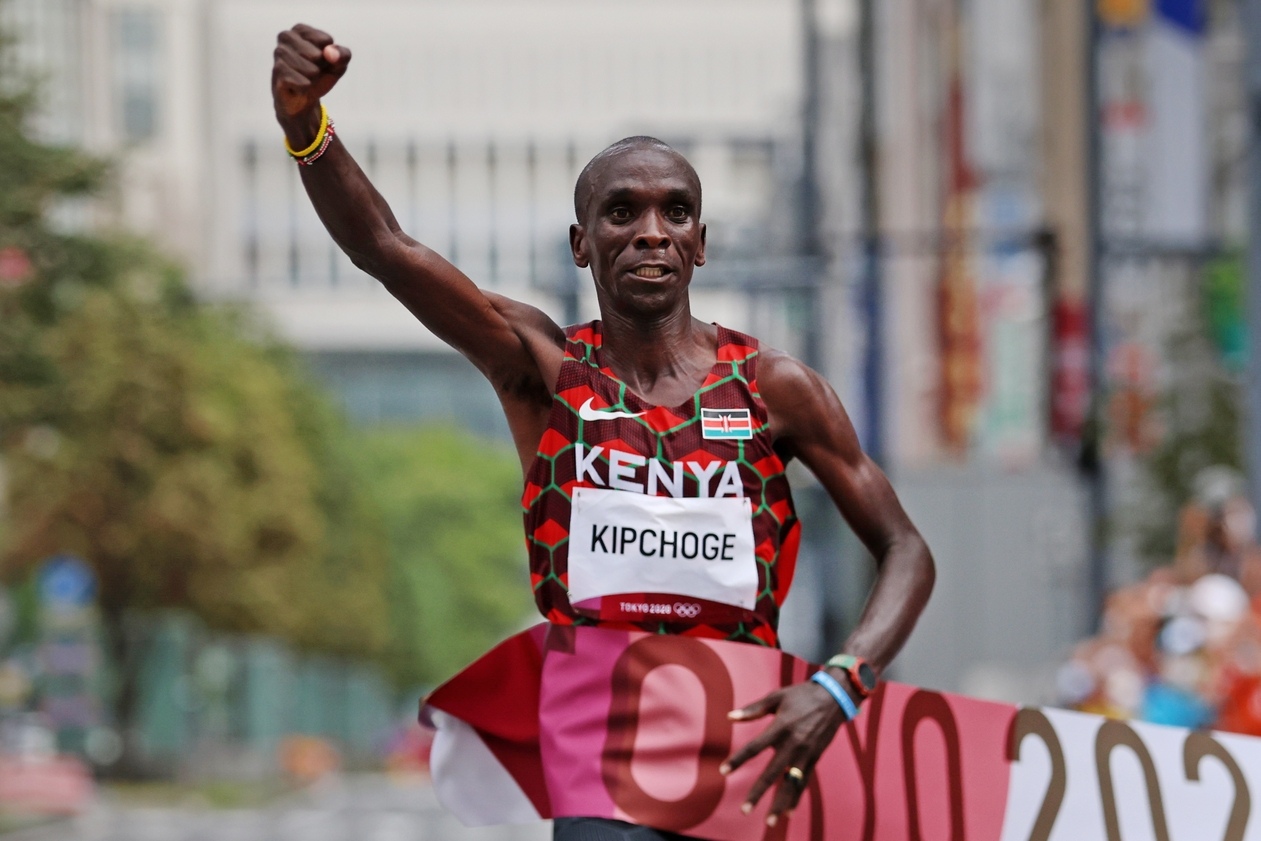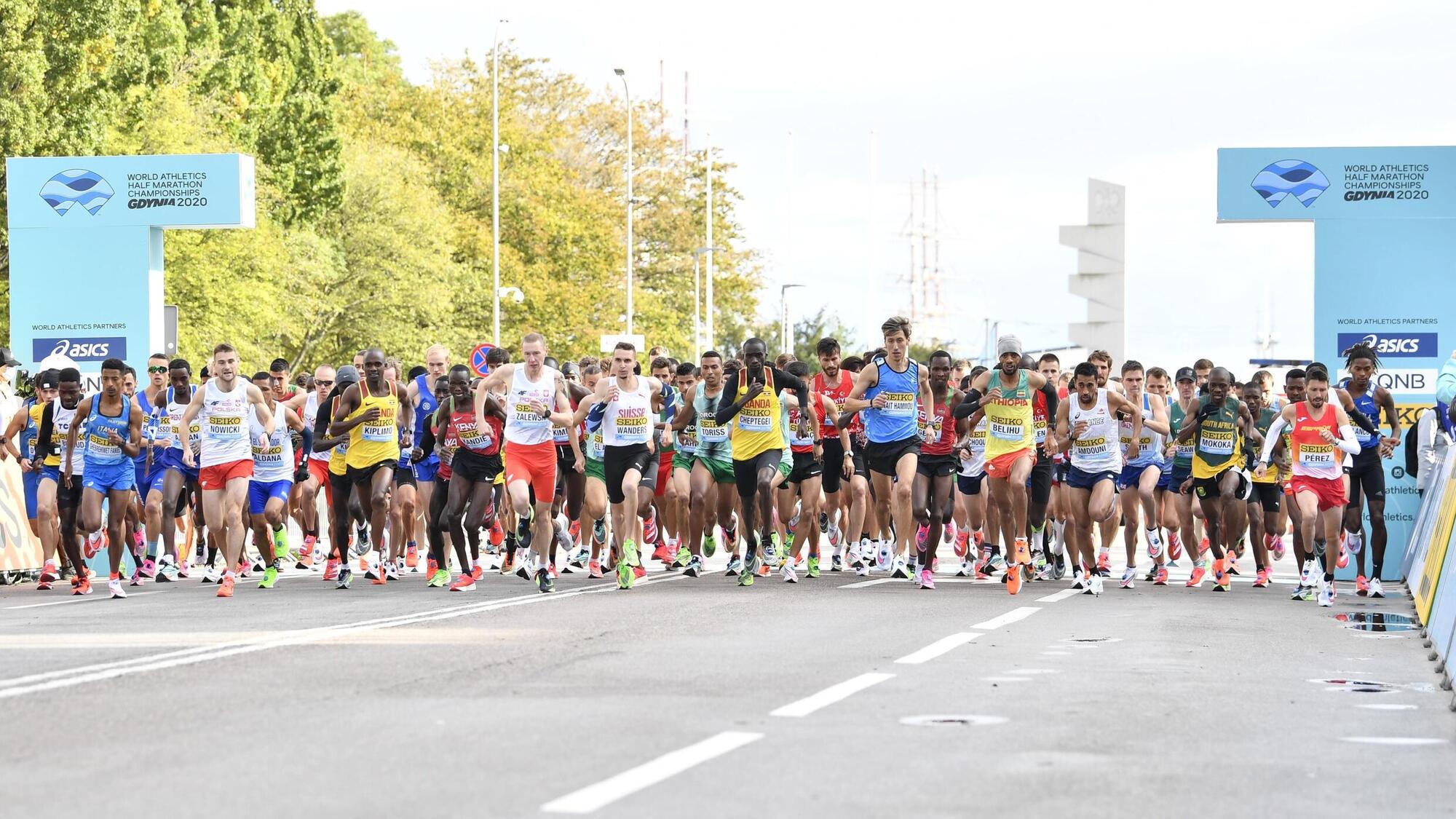Home>Misc>Featured>What Type Of Energy Is Used When Running A Marathon


Featured
What Type Of Energy Is Used When Running A Marathon
Modified: January 22, 2024
Discover the Featured type of energy powering marathon runners. Find out how they harness their endurance while achieving incredible feats of athleticism.
Introduction
Running a marathon is a strenuous endeavor that requires immense physical and mental stamina. It’s not just about endurance and determination; it also involves the efficient management of energy. To keep going for 26.2 miles, marathon runners rely on various types of energy sources.
In this article, we will explore the different types of energy utilized during a marathon and the factors that affect energy usage. Understanding how the body fuels itself during this intense physical activity can provide valuable insights for both seasoned runners and those aspiring to conquer the marathon distance.
Whether you are a casual runner or a competitive athlete, it is essential to comprehend the different energy systems at work during a marathon. This knowledge will enable you to optimize your training, nutrition, and race-day strategies, ensuring that you have the energy reserves necessary to cross the finish line.
So, let’s dive into the world of marathon running and uncover the secrets behind the energy sources that power these remarkable feats of endurance.
Types of Energy Utilized during a Marathon
When it comes to running a marathon, the body relies on several sources of energy to fuel its performance. These energy sources include carbohydrates, fats, proteins, and adenosine triphosphate (ATP).
1. Carbohydrate Energy: Carbohydrates are the body’s preferred source of fuel during intense exercise, such as marathon running. The body converts carbohydrates into glucose, which is then used to produce ATP, the energy currency of the cells. The muscles and liver store carbohydrates in the form of glycogen, which can be readily accessed during exercise.
2. Fat Energy: Besides carbohydrates, the body also utilizes fat as an energy source during a marathon. As the duration of the run increases, the body starts to rely more on fat oxidation to meet its energy demands. Fat stores in the adipose tissue are broken down into fatty acids, which are then transported to the muscles and converted into ATP.
3. Protein Energy: Proteins play a minor role in providing energy during a marathon. They are not the body’s preferred source of fuel but may be broken down to amino acids in extreme cases of energy depletion. However, relying on protein energy can have negative consequences, as it can lead to muscle breakdown and hinder muscle repair and recovery.
4. ATP Energy: Adenosine triphosphate (ATP) is the primary energy currency in the body, used for all cellular activities, including muscle contractions during running. The body stores a limited amount of ATP, only enough to sustain a few seconds of high-intensity exercise. To replenish ATP stores during a marathon, the body relies on the breakdown of carbohydrates and fats.
While all these energy sources contribute to marathon performance, the ratio at which they are utilized can vary depending on several factors, such as the duration and intensity of the run.
Carbohydrate Energy
Carbohydrates play a crucial role in providing energy during a marathon. They are the body’s primary and preferred fuel source, especially during high-intensity exercise.
During a marathon, the body converts carbohydrates into glucose, which is then utilized to produce adenosine triphosphate (ATP), the energy currency of the cells. The muscles and liver store carbohydrates in the form of glycogen, which can be readily broken down and used as fuel during exercise.
When you consume carbohydrates in your diet, they are broken down into glucose, which enters the bloodstream. The glucose is then transported to the working muscles, where it is used to produce ATP through a process called glycolysis.
The availability of carbohydrates in the body has a direct impact on marathon performance. It is recommended for runners to consume a carbohydrate-rich meal or snack before a race to maximize glycogen stores. This helps to delay the onset of fatigue and ensures a steady supply of energy throughout the race.
During a marathon, the body’s carbohydrate stores become depleted, especially as the intensity and duration of the run increase. When the glycogen stores start to dwindle, the body may begin to rely more on fat oxidation for energy. However, it is essential to maintain a sufficient level of carbohydrates throughout the race to prevent hitting the dreaded “wall” or experiencing a significant drop in performance.
Runners often consume carbohydrate-based gels, sports drinks, or energy bars during a marathon to maintain their energy levels. These products provide a quick source of carbohydrates that can be easily absorbed and utilized by the body.
It is crucial to note that the amount of carbohydrate energy needed during a marathon varies depending on several factors, including the runner’s body composition, training status, and race intensity. Planning and implementing a proper carbohydrate-loading strategy and fueling plan can significantly impact marathon performance and help runners reach their goals.
Fat Energy
Fat provides a significant source of energy during a marathon, especially as the duration of the run increases. While carbohydrates are the body’s preferred fuel source, fat plays a crucial role in meeting energy demands during prolonged endurance activities.
During a marathon, when glycogen stores become depleted, the body starts to rely more on fat oxidation to sustain energy levels. Fat is stored in adipose tissue in the form of triglycerides. These triglycerides are broken down into fatty acids, which can be utilized as fuel by the muscles.
The process of fat oxidation involves the breakdown of triglycerides into glycerol and fatty acids. The fatty acids are transported to the muscles, where they undergo beta-oxidation, a series of chemical reactions that convert them into acetyl-CoA. Acetyl-CoA then enters the Krebs cycle, also known as the citric acid cycle, to generate ATP, providing a sustained source of energy.
Compared to carbohydrates, fat stores in the body are abundant. Even lean individuals have a significant amount of stored fat, providing a virtually unlimited supply of energy during a marathon. This makes fat an essential fuel source, especially during long-distance running.
However, it is important to note that fat oxidation requires more oxygen compared to carbohydrate metabolism. As a result, its utilization becomes more prominent during lower-intensity exercise or when the oxygen demand exceeds the body’s ability to deliver oxygen efficiently.
For endurance runners, training the body to efficiently use fat as an energy source is crucial. Long, slow-distance runs and regular aerobic exercise can enhance the body’s ability to oxidize fat, enabling runners to use this energy source more effectively during a marathon.
While fat is an abundant source of energy, relying too heavily on fat oxidation can have its drawbacks. It is crucial to maintain a balance between fat and carbohydrate utilization during a marathon to prevent hitting the “wall” or experiencing a significant drop in performance.
Proper nutrition, including a balanced diet of carbohydrates and healthy fats, along with strategic training plans, can help ensure optimal fat utilization and improve marathon performance.
Protein Energy
While carbohydrates and fats are the primary sources of energy during a marathon, proteins also play a role, though a minor one, in providing fuel for the body.
Proteins are primarily known for their role in muscle development, repair, and maintenance. However, in extreme cases of energy depletion, such as in long-distance endurance events like marathons, the body may utilize proteins as an energy source.
During prolonged exercise, when glycogen stores are depleted, the body can break down muscle tissue to obtain amino acids. These amino acids can be converted into glucose through a process called gluconeogenesis, which allows them to enter the glycolytic pathway and produce ATP.
However, relying on protein for energy during a marathon is not ideal. The breakdown of muscle tissue can hinder muscle repair and recovery, leading to muscle damage and decreased performance in the long run.
To prevent significant muscle protein breakdown during a marathon, it is crucial for runners to ensure they have an adequate intake of carbohydrates and fats to meet their energy needs. Consuming a balanced diet that includes sufficient carbohydrates, healthy fats, and lean protein can help maintain muscle mass and support performance during a marathon.
Additionally, consuming protein-rich foods after the race can aid in muscle recovery and repair, helping to minimize post-race soreness and promote faster healing.
It’s important to note that the primary role of proteins in marathon running is not to serve as an immediate energy source but rather to support muscle function and repair. Adequate protein intake is crucial for overall performance and recovery, but it should be balanced with sufficient carbohydrates and fats to optimize energy utilization during a marathon.
ATP Energy
Adenosine triphosphate (ATP) is the primary energy currency in the body, utilized for all cellular activities, including muscle contractions during a marathon. While carbohydrates, fats, and even proteins can be used to produce ATP, they are ultimately broken down into their basic components to generate this vital energy source.
The body stores a limited amount of ATP, enough to sustain only a few seconds of high-intensity exercise. To ensure a continuous supply of ATP during a marathon, the body relies on the breakdown of carbohydrates and fats.
During the early stages of a marathon, when the intensity is high, the body predominantly relies on ATP stored within the muscle cells. This immediate ATP supply provides the initial burst of energy required for a fast start. However, this store quickly becomes depleted.
To replenish ATP stores during a marathon, the body begins breaking down carbohydrates through glycolysis and fat oxidation. These processes release energy and enable the production of ATP to sustain endurance exercise.
Carbohydrates are broken down into glucose, which enters the glycolytic pathway. Here, glucose is metabolized to produce ATP, providing a readily available and efficient energy source.
Fat, on the other hand, is broken down into fatty acids through a process called lipolysis. The fatty acids are then transported to the mitochondria, where they undergo beta-oxidation to produce ATP. Fat oxidation is a slower process compared to carbohydrate metabolism, but it provides a sustained source of energy, particularly during longer endurance efforts.
During a marathon, the body continuously adjusts the proportion of carbohydrates and fats it uses to produce ATP based on factors such as exercise intensity and the depletion of energy stores. As the race progresses and glycogen levels decrease, the body relies more on fat oxidation to meet its energy needs, conserving limited carbohydrate stores for high-intensity efforts or critical stages of the race.
Optimizing ATP energy production during a marathon requires proper fueling strategies, including maintaining carbohydrate intake to prevent glycogen depletion and ensuring adequate fat stores for sustained endurance. By understanding the body’s ATP energy system, marathon runners can better plan their nutrition and pacing strategies to maintain optimal energy levels throughout the race.
Factors Affecting Energy Usage during a Marathon
During a marathon, the amount and type of energy utilized by the body can vary depending on several factors. Understanding these factors is crucial for optimizing energy usage and improving performance. Here are some key factors that influence energy usage during a marathon:
1. Duration and Intensity of the Run: The duration and intensity of the marathon exert a significant influence on energy utilization. As the race progresses, glycogen stores deplete, and the body increasingly relies on fat oxidation. Marathon runners need to pace themselves to ensure a steady energy supply throughout the race.
2. Training and Fitness Level: Well-trained and fit athletes utilize energy more efficiently during a marathon. Regular endurance training enhances the body’s ability to use both carbohydrates and fats as energy sources, thus delaying fatigue and improving overall performance.
3. Nutrition and Hydration: Proper nutrition and hydration play a vital role in energy usage and performance during a marathon. Consuming an appropriate balance of carbohydrates, fats, and proteins before, during, and after the race helps maintain energy stores and prevent muscle breakdown. Adequate hydration is also crucial in maximizing energy utilization and preventing dehydration-related fatigue.
4. Body Composition: Body composition, particularly the ratio of muscle mass to fat mass, affects energy utilization during a marathon. In general, individuals with more muscle mass tend to have higher glycogen stores and may rely more on carbohydrates for energy. On the other hand, individuals with higher fat stores may have a greater capacity for fat oxidation.
5. Genetics: Genetic factors can influence how efficiently the body uses energy during exercise. Some individuals may be genetically predisposed to utilize carbohydrates more effectively, while others may have greater fat oxidation capacity. However, regardless of genetic factors, proper training and nutrition play a significant role in optimizing energy usage.
6. Environmental Conditions: Environmental conditions such as temperature, humidity, and altitude can impact energy usage during a marathon. Hot and humid conditions can increase energy expenditure due to greater sweat rates and thermoregulation. Additionally, running at high altitudes can affect oxygen availability and alter energy metabolism.
To optimize energy usage during a marathon, it is important for runners to consider these factors and develop a training and nutrition plan tailored to their individual needs. Strategically managing energy expenditure and fueling strategies can lead to improved performance and a more enjoyable race experience.
Duration and Intensity of the Run
The duration and intensity of a marathon play a significant role in determining the energy usage and fuel sources relied upon by the body. As the race progresses, energy demands increase, and the body must adapt to sustain the required effort over the entire distance.
During the early stages of a marathon, when the intensity is high, the body primarily relies on carbohydrates for energy. Carbohydrates are readily available and can be quickly converted into glucose, which is used to produce ATP—the energy currency of the cells.
As the race continues, the body begins to tap into its glycogen stores, which are stored carbohydrates in the muscles and liver. These glycogen stores provide a readily available source of fuel that can be converted into glucose to help maintain energy levels.
However, glycogen stores are limited, typically lasting for about 90 minutes to 2 hours of intense exercise. As glycogen stores deplete, the body starts to rely more on fat oxidation to meet its energy demands. Fat, being a more abundant source of energy, can sustain the body for longer durations.
During longer and less intense portions of the race, the body shifts its reliance to fat as the primary fuel source. Fat is broken down into fatty acids through lipolysis and transported to the muscle cells, where they undergo beta-oxidation to produce ATP.
The utilization of fat as an energy source during a marathon is more efficient in terms of energy production. However, fat oxidation requires more oxygen than carbohydrate metabolism, making it more prevalent during lower-intensity exercise or when oxygen availability is abundant.
It’s important to note that even during long-distance endurance events like marathons, the body still relies on a combination of carbohydrates and fats for energy. The ratio at which these fuel sources are utilized depends on the duration and intensity of the run.
A strategic approach to pacing is critical during a marathon to optimize energy usage. Starting too fast or maintaining an excessively high intensity can deplete glycogen stores early on, leading to early fatigue or hitting the “wall.” A well-planned pacing strategy ensures a balance of energy utilization between carbohydrates and fats throughout the race.
Ultimately, the duration and intensity of a marathon dictate the fuel sources utilized by the body. Understanding these dynamics helps runners plan their nutrition, hydration, and pacing strategies to optimize energy utilization and maintain performance over the course of the race.
Training and Fitness Level
Training and fitness level are crucial factors that influence energy usage during a marathon. Well-trained and fit athletes have a more efficient energy utilization system, allowing them to perform at a higher level and sustain their effort over a longer duration.
Endurance training plays a significant role in enhancing the body’s ability to use carbohydrates and fats as energy sources. Regular aerobic exercise, such as long-distance running or interval training, improves the muscles’ oxidative capacity, enabling them to utilize oxygen more efficiently.
With consistent training, the body becomes better at preserving glycogen stores and sparing carbohydrates for later stages of the race. Trained muscles also have a higher capacity for fat oxidation, enabling athletes to rely more on fat as an energy source and consequently preserve glycogen stores.
In contrast, individuals with lower fitness levels may have a more limited ability to utilize fat as fuel. As a result, they may deplete their glycogen stores more quickly and experience earlier fatigue during a marathon.
Training for a marathon also involves specific nutrition strategies to support energy utilization. This includes consuming adequate carbohydrates to replenish glycogen stores and provide the necessary fuel for long runs and intense training sessions.
Additionally, a well-rounded training program includes strength training to build and maintain muscle mass. Muscles act as glycogen reservoirs and enhance the body’s overall energy utilization efficiency. Strong muscles can help delay muscle fatigue and prevent excessive breakdown of protein for energy.
Overall, the level of training and fitness directly impacts energy usage during a marathon. Athletes who have put in the time and effort to develop their aerobic capacity, improve their muscle endurance, and optimize their energy systems will have a distinct advantage on race day.
It’s important for marathoners to gradually build up their training volume and intensity to allow the body to adapt and efficiently utilize energy sources. Consistency, proper fueling, and recovery strategies are key to achieving peak fitness and maximizing energy utilization during a marathon.
Nutrition and Hydration
Nutrition and hydration are vital factors that significantly impact energy usage during a marathon. Proper fueling and hydration strategies play a crucial role in optimizing performance, maintaining energy levels, and preventing fatigue.
Carbohydrates are the primary fuel source for marathon runners, and consuming adequate carbohydrates before, during, and after a race is essential. Carbohydrate-rich foods such as pasta, rice, bread, and fruits provide the necessary energy to replenish glycogen stores and sustain performance.
Proper timing of carbohydrate intake is also important. Consuming a meal rich in carbohydrates a few hours before the race can help ensure glycogen stores are fully topped up. Additionally, during the race, consuming easily digestible carbohydrates such as gels, energy bars, or sports drinks can provide a quick source of fuel to maintain energy levels.
Along with carbohydrates, fats play a role in providing sustained energy during a marathon. Including healthy fats from sources such as avocados, nuts, and seeds in the diet can help supply long-lasting energy and support overall fuel utilization.
Hydration is another critical aspect of energy management during a marathon. Proper fluid intake helps maintain blood volume, regulates body temperature, and supports optimal muscle function.
Adequate hydration begins even before the race starts. Pre-hydration involves drinking fluids in the hours leading up to the start to ensure the body is properly hydrated, especially on warmer days.
During the race, drinking fluids at regular intervals is essential to replace the fluids lost through sweat and maintain hydration. Sports drinks containing electrolytes can be particularly beneficial as they replace essential minerals lost through sweating and help maintain fluid balance.
It’s important to develop a hydration plan based on individual needs as sweat rates and fluid requirements can vary. Practice hydration strategies during training runs to determine the amount of fluids needed to stay hydrated and avoid overhydration or dehydration.
In addition to carbohydrates and fluids, protein intake is also important for muscle repair and recovery. Consuming sufficient protein after the race helps support the rebuilding and maintenance of muscle tissue, aiding in recovery and minimizing muscle soreness.
Nutrition and hydration strategies should be personalized to individual preferences, tolerances, and specific race conditions. Consulting with a sports nutritionist or dietitian can provide valuable guidance on optimal fueling and hydration plans for marathon training and race day.
Importance of Energy Management during a Marathon
Effective energy management is essential for successful performance during a marathon. Properly managing energy reserves helps to delay fatigue, prevent hitting the “wall,” and maintain a consistent pace throughout the race.
One of the key aspects of energy management during a marathon is ensuring adequate glycogen levels. Depletion of glycogen stores can lead to a sudden drop in energy levels, resulting in a significant decline in performance. By strategically fueling with carbohydrates before and during the race, runners can optimize glycogen stores and maintain a steady supply of fuel.
Another crucial element of energy management is pacing. Starting the race too fast or setting an unsustainable pace early on can deplete energy resources rapidly. By adopting a well-planned pacing strategy, runners can conserve energy and sustain a strong performance throughout the race.
Proper hydration is also a critical component of energy management. Dehydration can lead to decreased energy levels, impaired muscle function, and an increased risk of heat-related illnesses. Maintaining adequate fluid intake before, during, and after the race helps optimize energy utilization and overall performance.
Additionally, managing energy levels during a marathon involves making strategic decisions about when to consume additional fuel. This may include consuming carbohydrate gels, energy bars, or sports drinks at regular intervals to replenish energy stores and prevent fatigue.
By practicing energy management strategies during training runs, runners can familiarize themselves with their body’s energy needs and learn how to optimize fueling and hydration for race day. Experimenting with different approaches and assessing individual responses can help develop a personalized energy management plan.
Effective energy management not only improves race performance but also enhances the overall race experience. By avoiding sudden energy crashes and maintaining a steady flow of fuel, runners can stay focused, motivated, and mentally strong throughout the entire marathon.
Conserving and managing energy resources efficiently during a marathon is crucial for maintaining a strong pace, achieving personal goals, and crossing the finish line with a sense of accomplishment. By prioritizing energy management strategies, runners can maximize their potential and make the most out of their marathon experience.
Conclusion
Running a marathon is a true test of physical and mental endurance, and effective energy management is key to a successful race. Understanding the types of energy utilized during a marathon, such as carbohydrates, fats, proteins, and ATP, allows runners to optimize their fueling strategies and maintain energy levels throughout the race.
The duration and intensity of the run, along with training and fitness levels, significantly impact energy utilization. Proper nutrition and hydration play a vital role in energy management, with carbohydrates being the primary fuel source and hydration ensuring optimal performance.
By implementing strategic energy management techniques, such as pacing, fueling, and hydration plans, marathon runners can optimize their glycogen stores, utilize fats efficiently, and prevent muscle breakdown. These strategies help runners delay fatigue, prevent hitting the “wall,” and maintain a steady pace from start to finish.
It is important for each runner to tailor their energy management approach to their individual needs, taking into account factors like body composition, genetic predisposition, and environmental conditions.
In conclusion, mastering the art of energy management during a marathon is essential to achieve peak performance and a satisfying race experience. By understanding the different energy systems at work, implementing proper nutrition and hydration strategies, and maintaining a balanced training program, runners can optimize energy utilization, enhance endurance, and conquer the incredible challenge of completing a marathon. So lace up those running shoes, fuel up, hydrate, and go chase your marathon goals!









